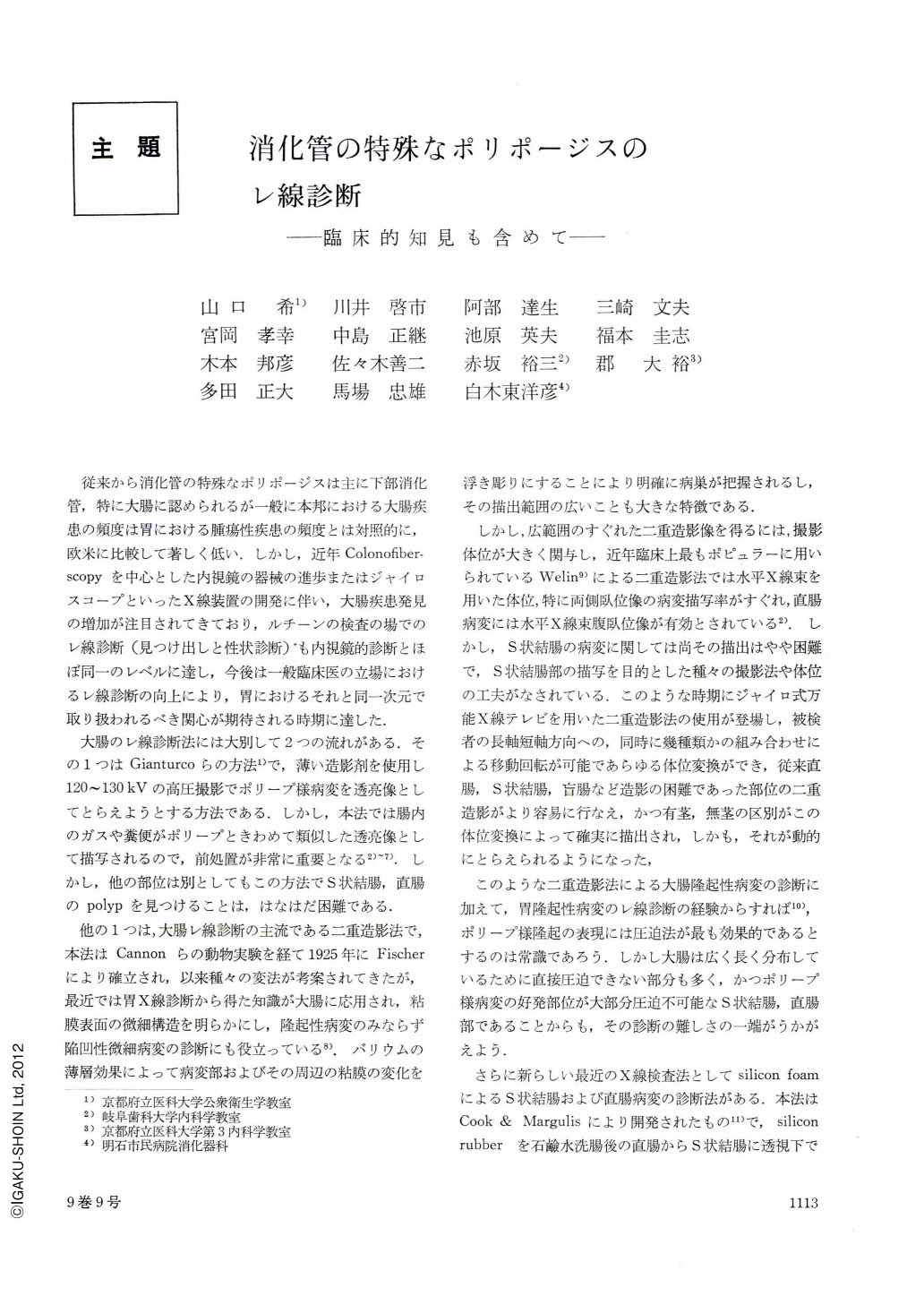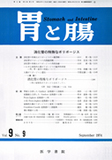Japanese
English
- 有料閲覧
- Abstract 文献概要
- 1ページ目 Look Inside
従来から消化管の特殊なポリポージスは主に下部消化管,特に大腸に認められるが一般に本邦における大腸疾患の頻度は胃における腫瘍性疾患の頻度とは対照的に,欧米に比較して著しく低い.しかし,近年Colonofiberscopyを中心とした内視鏡の器械の進歩またはジャイロスコープといったX線装置の開発に伴い,大腸疾患発見の増加が注目されてきており,ルチーンの検査の揚でのレ線診断(見つけ出しと性状診断)も内視鏡的診断とほぼ同一のレベルに達し,今後は一般臨床医の立揚におけるレ線診断の向上により,胃におけるそれと同一次元で取り扱われるべき関心が期待される時期に達した.
大腸のレ線診断法には大別して2つの流れがある.その1つはGianturcoらの方法1)で,薄い造影剤を使用し120~130kVの高圧撮影でポリープ様病変を透亮像としてとらえようとする方法である.しかし,本法では腸内のガスや糞便がポリープときわめて類似した透亮像として描写されるので,前処置が非常に重要となる2)~7).しかし,他の部位は別としてもこの方法でS状結腸,直腸のpolypを見つけることは,はなはだ困難である.
The incidence of diseases of the colon is relatively low as compared with that of the western countries. Specific polyposis originating chiefly in the lower digestive tract is also not exempt from this fact. However, the positive rate of detection in these diseases is becoming higher in the routine examination by x-ray supplemented by endoscopy according as clinicians are increasingly interested in them. Methods of x-ray examination for them include (1) high voltage exposure as proposed by Gianturce et al., by which polypoid lesions are depicted as translucencies; and (2) double contrast study that delineates minutely not only how protruding lesions are raised above the mucosal surface but also their surface intself. Recently, double contrast method has become more effective by the aid of all-round gyro x-ray TV to such a degree that regions hitherto hard to visualize in x-ray such as the rectum and sigmoid are now more easily examined. In particular, dynamic observation is now possible of pedunclated polyps in these regions. Furthermore, under fluoroscopy a silicone foam is put intothe rectum up to the sigmoid to produce a silicone cast. More accurate diagnosis is made possible by examining it as well as exfoliated cells adhering to its surface. With these new weapons as a “pull” behind us, differential diagnosis by histology is theoretically possible between those adenomas belonging to familial polyposis coli or other polyposis coli syndromes (Gardner's, Zanca's and Turgot's syndromes) and to Cronkhite-Canada's syndrome and hamartoma to which Peutz-Jeghers syndrome belongs. Differential diagnosis would be all the more easier in conjunction with the study of hereditary transmission in these syndromes, accompanying findings of the polyps and their predilection sites. In practice, however, when a polyp is small, roentgenographic difference between adenoma and hamartoma is difficult to achieve, because the smaller the lesion is, the less distinct is the regularity of its development. On the other hand, when a polyp is large enough permitting distinction, adenoma begins to show features of an epithelial neoplasm, stressed by its surface harder and more rough and granular. Althongh hamartomatous polyp, of smooth surface when solitary, may also show uneven and rough surface when it grows up and becomes conglomerate, it retains as a rule soft consistency. In reality, however, the distinction between the two is not so clearcut. In addition to endoscopic findings, histologic study of biopsied specimen taken undor direct vision is therefore indispensable.
It is a well known fact that these diseases are associated with cancer of the colon in a high percentage. Aside from the standpoint of malignant transformation of the polyps to be detected easier by the improvement of x-ray diagnosis, another problem awaiting solution is the investigation of the basis involving the mechanism of cancer development from the standpoint of immunology.

Copyright © 1974, Igaku-Shoin Ltd. All rights reserved.


